
One cherry pick led Ryan to sharing over a decade with NFFTT
Not Far From The Tree is noticing that fruit damage from pests is now impacting the ability to donate fruit to many community agencies, and is leaving trees unpickable. Fruit that has pest damage must be processed for safe consumption (cleaned, cut, cooked) and many agencies that NFFTT donates to do not have the facilities to process fruit.
Fruit provides many different functions in small yard ecosystems, and you may find that fruit is involved in the completion of the lifecycle of an insect pest. These pests often leave the tree itself alone, but cause a great deal of damage to the fruit. Sometimes this damage is simply cosmetic in nature, but more often than not, there is also an impact on overall fruit health/usability.
The larvae of these pests burrow into the flesh of the fruit during their growth stages, and eventually exit as adults to reproduce elsewhere. The key is to interrupt the pest life cycle so that the insect larvae in any fallen fruit cannot enter the soil under your tree to overwinter.
Literally! As fruits like apples and pears begin to fall this month, we need to take action by cleaning up any fallen fruit, and by removing any fruit on the tree showing signs of pest damage.
If left untreated, NFFTT knows that pest damage will get worse. More fruit on the tree will become infested, and more of the flesh on each fruit will be damaged. There are 3 pests in particular that we’re seeing a lot in the NFFTT fruit tree canopy: Codling Moth, Apple and Cherry Maggot Fly. All three are managed in part through better hygiene practices.

Check the fruit growing on the tree and pick any infected fruit. Look for dimpled skin, brown or rotten trails in the flesh, or fruit showing crumbly frass-filled holes.
Clean up all fallen fruit around the base of the tree.
Dispose of all fruit by placing it in a plastic bag in the garbage, not compost or organic waste.
Managing Codling Moth in Home Orchards
Mating disruption for codling moth and oriental fruit moth

Join Not Far From The Tree, home growers, arborists and small scale orchardists from across North America and around the world in 5-star-rated organic fruit tree care education with Orchard People’s interactive, instant access courses.
Find courses like: Certificate in Fruit Tree Care; Fruit Tree Pruning Masterclass; Managing Fruit Tree Pests & Disease; Soil Essentials for Fruit Trees; and so many more!
Or, tune in to the Orchard People podcast! Join live and submit your questions to an expert guest, or catch the show later on your favorite platform.

One cherry pick led Ryan to sharing over a decade with NFFTT

Maddie’s love for NFFTT’s model of shared abundance